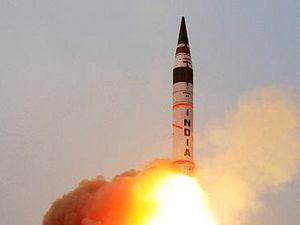India’s Strategic Forces Command is reportedly getting ready to test launch the Agni-V intercontinental ballistic missile (ICBM) in its final operational configuration from Wheeler Island, off the coast of the eastern Indian state of Odisha, in late December or early January, according to local media reports.
The Strategic Forces Command has previously conducted three test-launches of India’s first ICBM, the last of which occurred in January 2015. While two of the previous launches, taking place in April 2012 and September 2013 respectively, had the Agni-V tested in “open configuration,” the January 2015 test involved the launch of ICBM from a hermetically sealed canister mounted on a mobile transporter erector launcher in so-called “deliverable configuration.”
The upcoming test had to be delayed due to some technical issues. “There were some minor technical snags in Agni-V, which required tweaking of its internal battery and electronic configurations after its last test in January 2015,” an unnamed source told The Times of India. “This will be the final test of the three-stage Agni-V, which will be tested for its full range, before the Strategic Forces Command begins its user trials,” the source added.
The Agni-V, a three-stage solid fueled missile, has an approximate range of 5,500-5,800 kilometers, and can carry a 1,500-kilogram (3,300-pound) nuclear warhead. India has reportedly also been working on multiple independently targetable reentry vehicles (MIRV) for the Agni-V in order to ensure a credible second strike capability. In addition, India is already working on the Agni-V’s successor, the Agni-VI, most likely a four-stage ICBM with MIRV and a maneuverable reentry vehicle (MaRV) capability.
“India has successfully test fired [the] nuclear capable Agni-V missile recently, which has a range of 5,000 kms. But we are capable of developing ICBM that can hit targets beyond the range of 10,000 kilometers,” K. Salwan, the chairman of the Armament Research Board at India’s Defense Research and Development Organization (DRDO), announced in April 2015, as The Diplomat reported. The DRDO chairman was likely referring to the Agni-VI.
Whereas previous Agni variants, the Agni-I, Agni-II, and Agni-III, were specifically developed to offset Pakistan’s nuclear arsenal, the Agni-IV and Agni-V, given their longer ranges, are specifically designed to deter China. The Agni-V will be fully road mobile. There have also been reports that the ICBM will be stationed aboard India’s first domestically developed and built ballistic missile nuclear submarine (SSBN) class.
India has a nuclear warfare policy centered on a No First-Use (NFU) doctrine and keeps its nuclear warheads de-mated from the actual missiles. Consequently, parts of India’s nuclear doctrine will need to be revised should future Indian Navy submarines carry nuclear-capable submarine-launched ballistic missiles and conduct deterrence patrols.

































